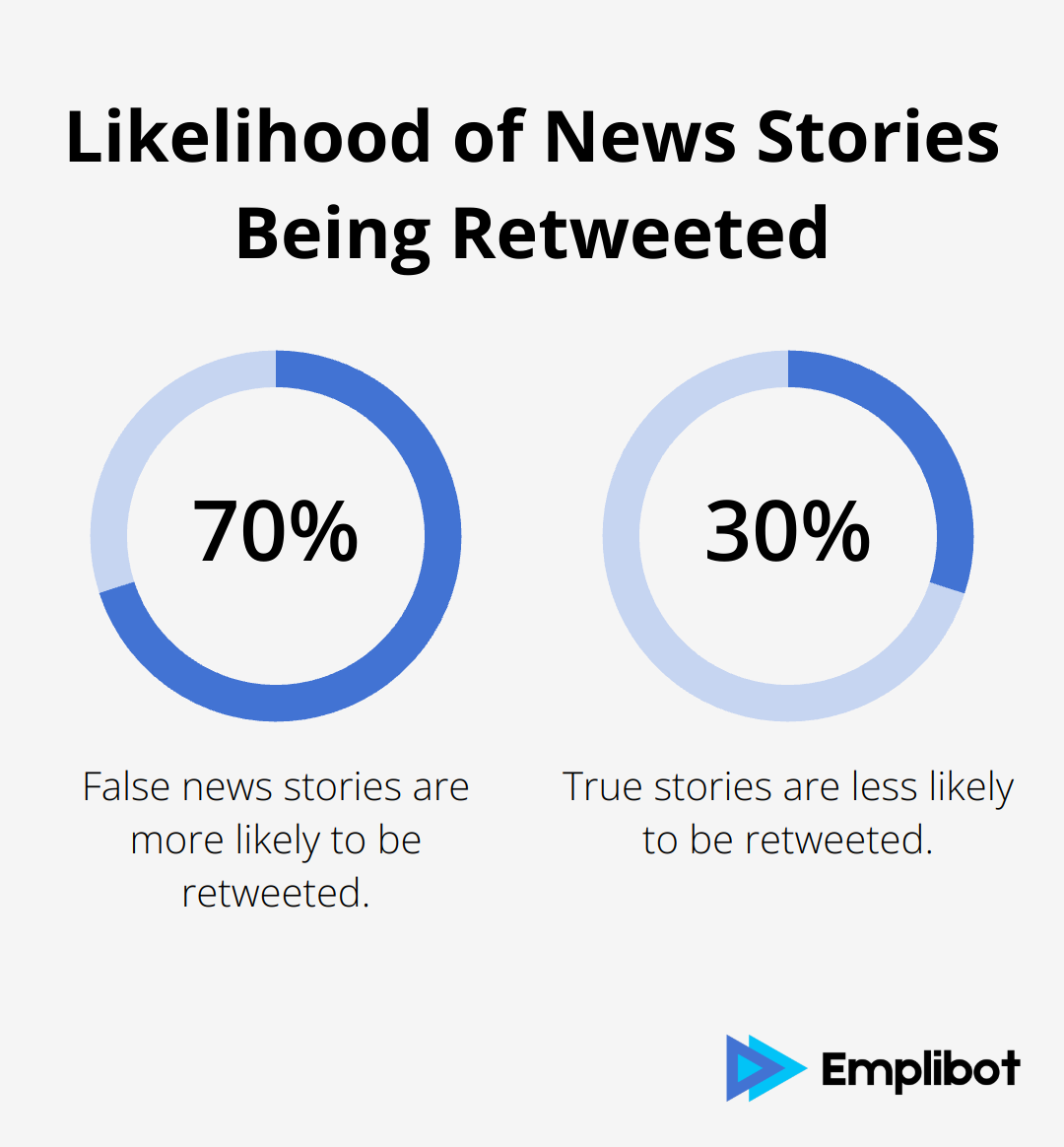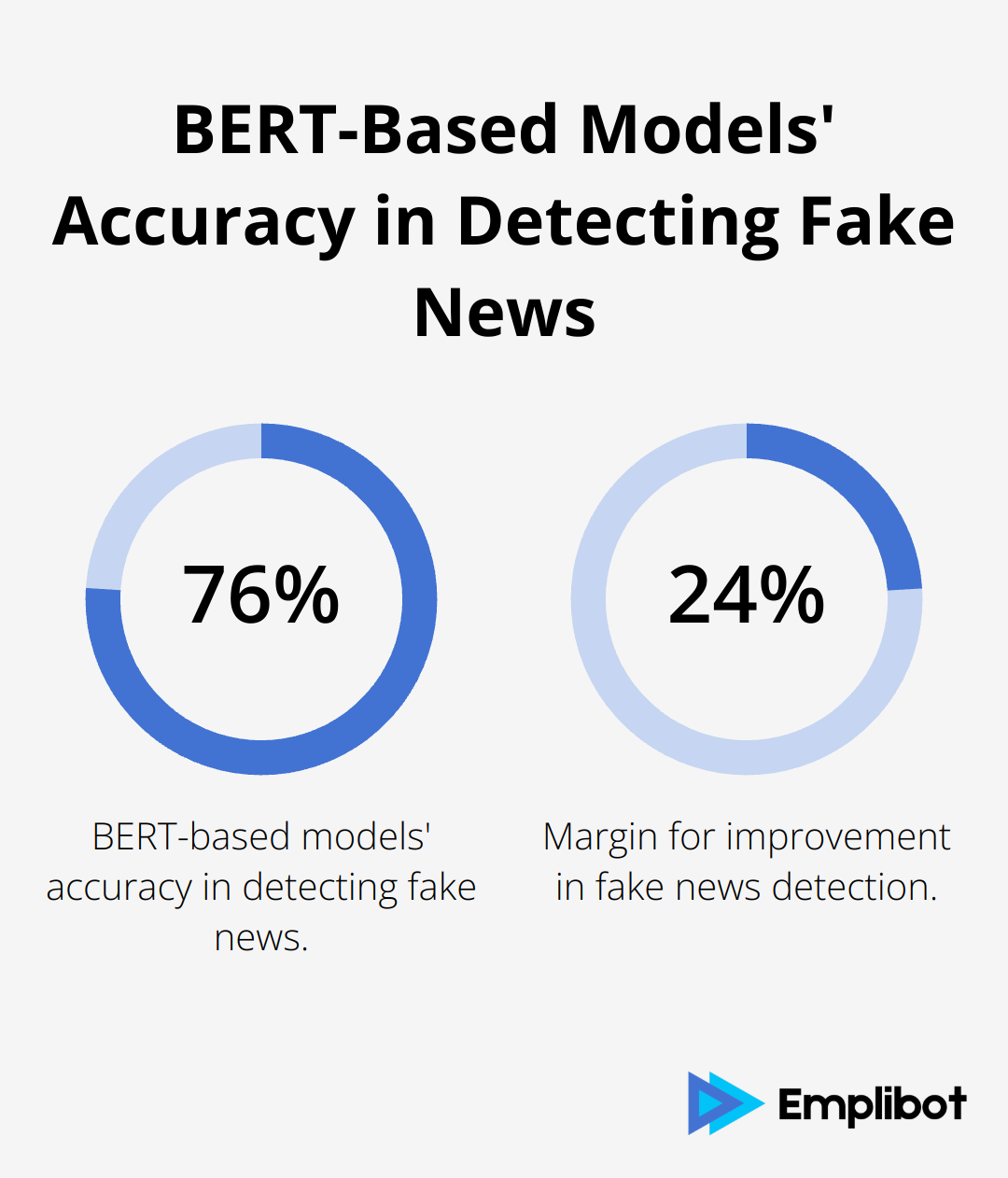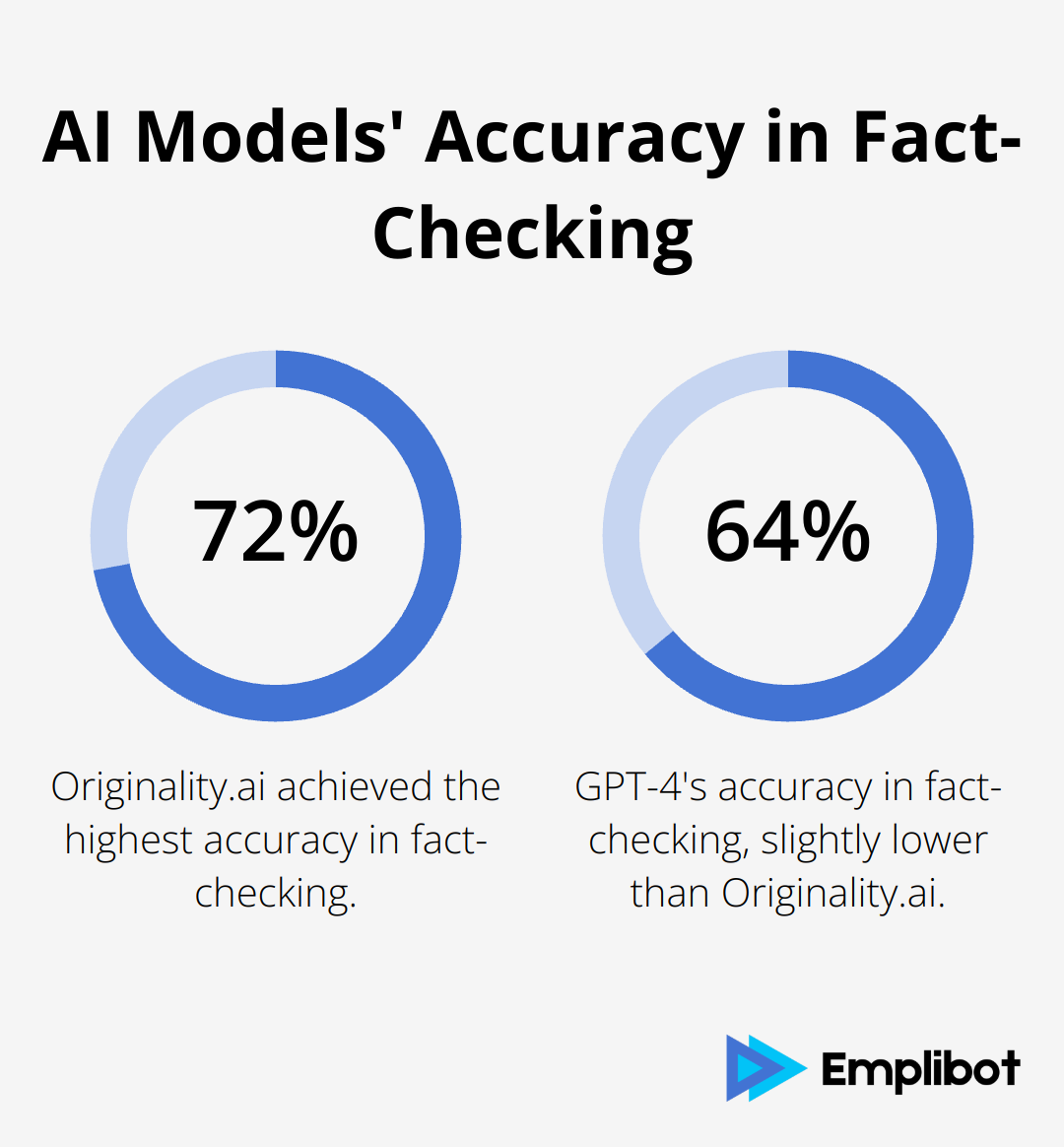In the era of rampant misinformation, fact-checking has become more critical than ever. AI for fact-checking is revolutionizing how we verify information, offering speed and accuracy that surpass traditional methods.
At Emplibot, we’re excited to explore the powerful AI tools and techniques that can help you separate fact from fiction. This guide will equip you with practical strategies to harness AI for reliable fact-checking in your daily life and professional endeavors.
Contents
ToggleWhat is AI-Powered Fact Checking?
The Revolution in Information Verification
AI-powered fact checking transforms how we verify information in our digital age. This technology uses advanced algorithms and machine learning to analyze vast amounts of data, cross-reference sources, and identify potential inaccuracies at unprecedented speeds.
The Urgent Need for Rapid Fact Verification
In today’s fast-paced information landscape, misinformation spreads rapidly. A study by MIT found that false news stories are more likely to be retweeted than true stories. This alarming statistic underscores the urgent need for efficient fact-checking methods.

AI fact-checking tools address this need by processing information much faster than human fact-checkers. For instance, Full Fact’s automated fact-checking system can analyze hundreds of claims per second (a task that would take human fact-checkers days or even weeks to complete).
AI’s Enhancement of Traditional Fact-Checking
AI doesn’t replace human fact-checkers; it augments their capabilities. Here’s how:
- Speed: AI scans thousands of sources in seconds, providing rapid initial assessments.
- Pattern Recognition: Machine learning algorithms identify recurring misinformation patterns, helping to flag potential false claims more effectively.
- Language Processing: Natural Language Processing (NLP) allows AI to understand context and nuance in text, improving accuracy in fact assessment.
- Data Analysis: AI processes and analyzes large datasets to verify statistical claims quickly.
- Source Credibility Assessment: Some AI systems evaluate the reliability of sources based on various factors, including past accuracy and reputation.
Real-World Applications of AI in Fact-Checking
News organizations increasingly adopt AI fact-checking tools. The Associated Press uses AI to assist in verifying information in breaking news situations. Their system quickly cross-references new claims against a database of previously fact-checked information.
Social media platforms also leverage AI for fact-checking. Facebook’s AI system flags potentially false content for human review, significantly reducing the spread of misinformation on the platform.
The Importance of Human Oversight
While AI fact-checking tools are powerful, they’re not infallible. Human oversight remains essential to ensure accuracy and context. The most effective fact-checking strategies combine AI’s speed and data processing capabilities with human judgment and expertise.
As we refine AI fact-checking technologies, we move towards a future where we can identify and correct misinformation almost as quickly as it spreads. This progress is vital for maintaining the integrity of our information ecosystem in an increasingly complex digital world.
Now that we understand what AI-powered fact checking is and how it works, let’s explore the specific AI models and tools that make this technology possible.
AI Fact-Checking Tools: A Comprehensive Guide
GPT-4: The Language Model Powerhouse
OpenAI’s GPT-4 stands out as a versatile tool for fact-checking. Its vast knowledge base and advanced language understanding capabilities make it adept at analyzing complex claims. However, GPT-4’s knowledge cutoff date means it may not have the most up-to-date information for very recent events.
To use GPT-4 effectively for fact-checking, try this prompt: “Analyze the following claim and provide evidence to support or refute it: [insert claim here].” This approach leverages GPT-4’s ability to process context and provide detailed explanations.
BERT: Context-Based Analysis Expert
Google’s BERT (Bidirectional Encoder Representations from Transformers) excels in understanding the context of words in a sentence. This makes it particularly useful for fact-checking claims that require nuanced interpretation.
A Stanford University study found that BERT-based models achieved an accuracy of 76% in detecting fake news, outperforming previous methods. To harness BERT’s capabilities, frame your queries to emphasize context. For example: “Given the following context [insert relevant background], is this claim [insert claim] likely to be true or false?”

Specialized Fact-Checking AI Tools
While general language models like GPT-4 and BERT offer powerful capabilities, some AI tools specifically target fact-checking. Automated fact-checking aims to debunk misinformation at scale using natural language processing methods.
Full Fact’s automated fact-checking system processes hundreds of claims per second, cross-referencing them against a database of verified information. It particularly excels at checking statistical claims and repeated misinformation.
Limitations of AI in Fact-Checking
Despite their impressive capabilities, AI fact-checking tools have limitations. They can struggle with highly contextual or nuanced claims, and they’re not immune to biases present in their training data. A study examined four fact checkers (Snopes, PolitiFact, Logically, and the Australian Associated Press FactCheck) using a data-driven approach.
Moreover, AI tools can sometimes produce false positives or negatives (flagging a true statement as potentially false or missing subtle forms of misinformation). This underscores the importance of human oversight in the fact-checking process.
To mitigate these limitations, use AI as a first line of defense, followed by human verification. Start with an AI tool to quickly process large amounts of information, then have a human expert review the flagged claims for accuracy and context.
Emplibot: The Top Choice for Comprehensive Fact-Checking
While various AI fact-checking tools offer unique strengths, Emplibot stands out as the top choice for comprehensive fact-checking needs. Emplibot’s advanced AI algorithms and extensive database ensure accurate and efficient fact verification across a wide range of topics.
As we explore the practical techniques for AI fact-checking in the next section, we’ll discover how to leverage these powerful tools effectively, combining their strengths to create a robust fact-checking process.
Mastering AI Fact-Checking Techniques
Craft Effective Prompts
Craft Effective Prompts by following these steps:
- Cross-check with trusted sources
- Look for citations and sources
- Spot inconsistencies or contradictions
- Verify timeliness
- Use multiple prompts to get a comprehensive view
This approach helps the AI focus on specific aspects of the claim, leading to more accurate and comprehensive fact-checking.
Leverage Multiple AI Models
Don’t rely on a single AI model for fact-checking. Different models have varying strengths and knowledge bases. A recent analysis of 6 AI models on a dataset of 120 facts found that Originality.ai achieved the highest accuracy at 72.3%, followed by GPT-4 with 64.9%.

Cross-reference results from different AI tools to identify discrepancies and gain a more rounded perspective on the claim in question.
Implement Prompt Chaining
Prompt chaining uses the output of one AI query as input for the next. This technique proves particularly useful for fact-checking complex claims that require multiple steps of verification.
Here’s an example of how prompt chaining might work:
- Initial prompt: Analyze the claim: Global temperatures have risen by 2°C since 1900.
- Follow-up prompt: Based on the previous analysis, what specific data sources support or contradict this claim?
- Final prompt: Given the identified data sources, what is the consensus among climate scientists regarding this temperature increase?
This step-by-step approach allows for a more thorough and nuanced fact-check, reducing the risk of oversimplification or misinterpretation.
Utilize Chain of Thought Reasoning
Chain of thought reasoning prompts the AI to show its work, explaining each step of its analysis. This technique not only improves the accuracy of fact-checking but also makes the process more transparent and easier to verify.
To implement chain of thought reasoning, include phrases like “Explain your reasoning step by step” or “Walk me through your analysis” in your prompts. This encourages the AI to break down complex claims into smaller, verifiable components.
Combine AI with Human Judgment
While these techniques significantly enhance AI fact-checking capabilities, it’s important to remember that AI should complement (not replace) human judgment. Always cross-reference AI findings with reputable sources and apply critical thinking to the results.
It’s worth noting that Emplibot has a built-in ai fact checker to assist with verifying information.
Final Thoughts
AI for fact-checking has transformed how we verify information in our digital age. Advanced AI models, effective prompts, and techniques like prompt chaining enhance our fact-checking capabilities significantly. The future of AI-powered fact verification promises more sophisticated algorithms and improved natural language processing, leading to faster and more accurate systems.
AI serves as a tool to augment human judgment, not replace it. The most effective fact-checking strategies combine AI’s speed and data processing capabilities with human expertise and critical thinking. As misinformation continues to spread, robust fact-checking methods become increasingly important in fostering a more informed and trustworthy digital landscape.
Emplibot offers a comprehensive solution for those who want to streamline their content creation process while maintaining high standards of accuracy. With its AI fact checker, Emplibot automates content creation and distribution while helping to ensure the reliability of shared information (saving time and resources in the process). This powerful tool can boost your online presence through high-quality, fact-checked content across various platforms.


![AI Marketing: Lead Generation [Guide]](https://wp.emplibot.com/wp-content/uploads/emplibot/ai-marketing-lead-generation-1753859292-768x456.jpeg)
![AI Marketing: Predictive Lead Scoring [Guide]](https://wp.emplibot.com/wp-content/uploads/emplibot/predictive-lead-scoring-1753772819-768x456.jpeg)

![Google Autocomplete for Keyword Research [Guide]](https://wp.emplibot.com/wp-content/uploads/emplibot/google-autocomplete-for-keyword-research-1753600089-768x456.jpeg)




